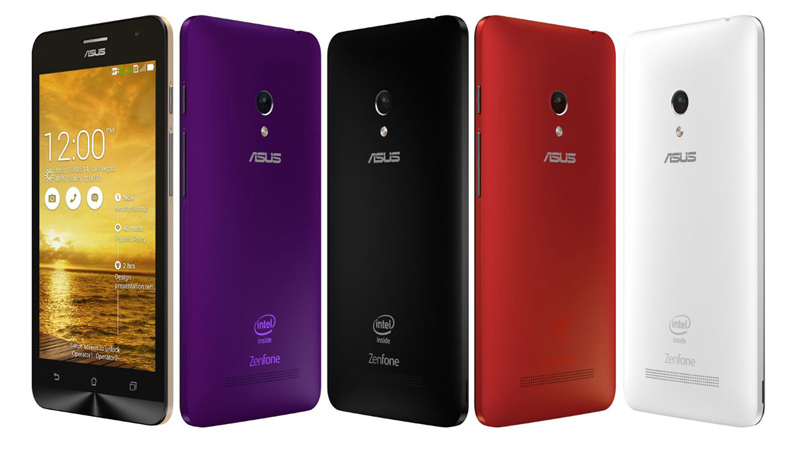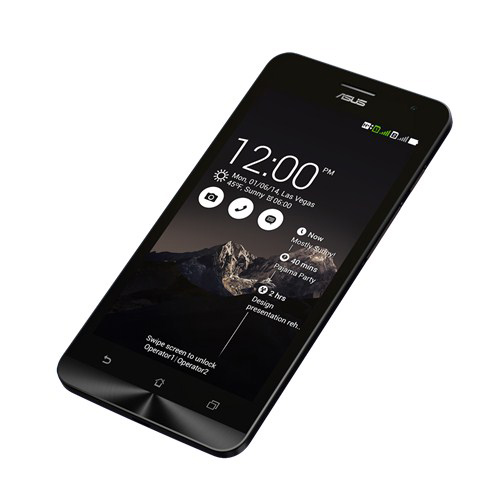Asus ZenFone 5 review: Price & availability in the UK
The ZenFone 5 (A501CG) is available to pre-order from Asus now for £179.99, though we think it’ll drop in price as third-party resellers begin to offer it after launch. The smartphone is set to be released in the UK on 20 October. There’s also a 4G version of the ZenFone 5 (A500KL) available, at a pre-order price of £199.99. It uses a different processor (a 1.2 GHz quad-core Qualcomm chip) to offer that 4G connectivity. We’ve tested the A501CG ZenFone 5 without 4G, so this review reflects that, but the design and specs aside from the processor and 4G connectivity are the same. At £179.99, the ZenFone 5 sits at the lower end of the mid-range smartphone market and with a price drop after launch could fit into the budget smartphone category, with rivals including the £165 Acer Liquid E3, the £155 HTC Desire 510, and the £145 Motorola Moto G 2014, among others.
Asus ZenFone 5 review: Design & build
As you may have guessed from its name, the ZenFone 5 has a 5in display. We find 5in to be ideal for a smartphone, so we preferred this ZenFone over the ZenFone 4 and ZenFone 6, but it really does come down to personal preference. Asus has managed to keep the bezels on the ZenFone 5 reasonably thin (though not as thin as some of the high-end smartphones like the LG G3), but it does get a bit chunky at its thickest point of 10.34 mm. (The HTC Desire 510 is 9.99 mm thick, but the Motorola Moto G is thicker at 11 mm).
We found it very comfortable to hold thanks to the way Asus has made the back of the ZenFone rounded – it’s thinner at the edges and gets thicker in the middle, fitting snuggly in the palm. The overall dimensions of the ZenFone 5 are 148 x 73 mm, so it’s possible to use it one-handed for many people. It should also fit in most pockets, and isn’t particularly heavy at 145 g. The ZenFone 5 has a plastic back with a soft matt finish made with a ceramic coating, which we like aside from its tendency to highlight fingerprints and marks. That back is removable, though, and you can swap it out for a variety of different colours including Charcoal Black, Pearl White, Cherry Red, Twilight Purple and Champagne Gold, as shown in the image at the top of this article. We found it a bit difficult to get the back case off, and you’ll need to do so in order to insert your SIM card and microSD card, but it does give a satisfying snap when you fit the case back on, with a tight fit that looks well-finished. You’ll notice a small portion of metal along the bottom of the case and the volume and power buttons on the side are also metal, with Asus’s trademark concentric circle design. They’re a nice little touch to make the ZenFone 5 look that bit more premium. However, on the review unit we tested, we noticed that there was a small gap between the metal portion and the start of the display, which quickly collected dirt and was difficult to clean. A second downfall to the ZenFone 5’s (and ZenFone 6’s) design is the buttons along the bottom of the display. They don’t have any backlight, so it’s tricky to know whether you’re hitting the right button when you’re using the smartphone in dark environments.
Asus ZenFone 5 review: Display
That 5in display is HD 1280×720 IPS, which makes a pixel density of 293ppi. That’s better than the 6in ZenFone, which has the same resolution so a lower pixel density. We found the ZenFone 5’s screen to be bright and crisp, and were very impressed by the viewing angles made possible thanks to the IPS panel. Asus also provides an app called Splendid for its ZenFones, which is designed to help you adjust the display to your liking. The ‘vivid’ mode works well for brightening and bolding up colours, for example, so we’d recommend having a play around with it.
Asus ZenFone 5 review: Hardware & performance
Inside the ZenFone 5 is an Intel Atom Z2580 quad-core processor clocked at 1.6 GHz. That’s paired with 2 GB RAM, meaning that this smartphone is definitely not sluggish. It’s responsive – apps were quick to launch and playing games was smooth enough for most casual smartphone gamers. We put the ZenFone 5 through our benchmark tests to give us an idea of how it compares with some of its rivals. It managed 13fps in our T-Rex GFXBench graphics test, which is better than the Motorola Moto G 2014’s 11fps and the Samsung Galaxy S5 mini’s 10fps, but not as impressive as the 14fps achieved by the £99 EE Kestrel. Geekbench 3 processor test results were 467 for single core (better than the Motorola Moto G 2014 and the Samsung Galaxy S5 mini) and 1081 for multicore, beating the Sony Xperia M2 but settling just behind the Motorola Moto G 2014 which managed 1144. In the SunSpider web browser test, the ZenFone 5 achieved a score of 1038ms. That puts this smartphone in line with the likes of the Samsung Galaxy S5 mini, the Samsung Galaxy S4 and just a bit slower than the LG G3 when it comes to web browsing.
The ZenFone 5 is available with 8- or 16 GB built-in storage, but Asus has included a microSD slot to allow up to 64 GB extra to be added. The ZenFone 5’s connectivity includes 802.11 b/g/n WiFi (not the faster 11ac standard, though) and Bluetooth 4.0, but there’s no NFC or IR Blaster. 4G support is only available in the other version of the ZenFone 5 mentioned previously in this review.
Asus ZenFone 5 review: Cameras
The camera in the ZenFone 5 is 8 Mp with an LED flash and an f/2.0 aperture that uses the company’s PixelMaster technology. We were a bit disappointed by the ZenFone 5’s camera after loving the 13 Mp camera that the ZenFone 6 sports, as the results seemed to be over sharpened. It’s not a bad camera, but it’s certainly not the best we’ve seen on a mid-range smartphone, or even a budget smartphone for that matter. You can take a look at an example of the photos you can expect to achieve with the ZenFone 5 below. Click the image to enlarge.
Below is a full-size crop of that image to give you a better idea of the quality of the image.
Like the ZenFone 6, the ZenFone 5 offers a low-light mode that detects when you’re in a dark environment to help increase the light sensitivity, decrease noise and boost colour contrast, and we found that it works really well. Other modes include Time Rewind, which captures a total of 31 photos in a short burst to help you get the best outcome, Panorama, a special Selfie mode for the rear-camera, a Depth of Field and Miniature mode and a smart remove mode that lets you get rid of unwanted objects with some success.
There are lots of other filters and effects to play with for some Instagram-like results, and even a GIF Animation mode if that’s what you’re into. On the front of the ZenFone 5 is a 2 Mp camera with an f/2.4 aperture that’ll do the trick for selfies and video calls. Video with the rear-camera was very disappointing, though. It’s cable of recording 1080p but it continuously stutters and lags so we wouldn’t recommend buying this smartphone if recording video is important to you.
Asus ZenFone 5 review: Software
We really enjoy using Asus’s ZenUI interface on the company’s tablets, so we’re pleased to see that the company has introduced it to its smartphone range. It uses Android 4.3 Jelly Bean (no 4.4 KitKat, unfortunately). See also: Asus MemoPad 7 review The bold colours, flat design combined with simple navigation that’s easy to get used to make ZenUI particularly appealing, and we like the apps Asus has designed such as What’s Next for a quick look at your schedule and Do It Later to remind you to reply to an email, watch a YouTube video, return a phone call and more.
Asus ZenFone 5 review: Battery life
We found the battery life of the ZenFone 5 to be really good, just as we did with the ZenFone 6. Using the ZenFone 5 to send emails, browse social media, send messages, make phone calls, play games and watch videos on the commute, we found that we could get away with charging the device once every two days. Asus’s Power Saver app is useful. We switched on Optimised mode and Smart Saving, which didn’t impair our use of the phone at all but definitely seemed to prolong the battery life.
There’s also an Ultra-saving mode to squeeze even more battery life out of the phone without going so far as to make the content black and white like some smartphones do, and the option to customise your own battery saving mode. Ashleigh is Tech Advisor’s Head of Affiliate. Providing expert buying advice you can trust is her forte, helping you to find the most reputable consumer tech products and services, and ensuring you don’t spend a penny more than you should.







